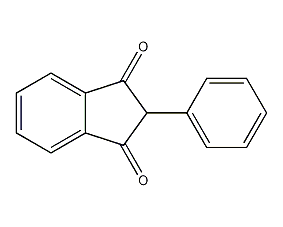2-phenyl-1,3-indandione

Structural formula
| Business number | 01TD |
|---|---|
| Molecular formula | C15H10O2 |
| Molecular weight | 222.24 |
| label |
phenylindione, Phenindione |
Numbering system
CAS number:83-12-5
MDL number:MFCD00003782
EINECS number:201-454-4
RTECS number:NK6125000
BRN number:1911699
PubChem number:24898344
Physical property data
1. Character:It is white or milky white soft crystal; almost odorless and tasteless
2. Density (g/mL,25/4℃): Unsure
3. Relative vapor density (g/mL,AIR=1): Unsure
4. Melting point (ºC):148-151
5. Boiling point (ºC,Normal pressure):243.3
6. Boiling point (ºC,5.2kPa): Unsure
7. Refractive index: Uncertain
8. Flashpoint (ºC): Unsure
9. Specific optical rotation (º): Unsure
10. Autoignition point or ignition temperature (ºC): Unsure
11. Vapor pressure (kPa,25ºC): Unsure
12. Saturated vapor pressure (kPa,60ºC): Unsure
13. Heat of combustion (KJ/mol): Unsure
14. Critical temperature (ºC): Unsure
15. Critical pressure (KPa): Unsure
16. Oil and water (octanol/Log value of water) partition coefficient: Uncertain
17. Explosion limit (%,V/V): Unsure
18. Lower explosion limit (%,V/V): Unsure
19. Solubility:Very slightly soluble in water, slightly soluble in ethanol, ether, soluble in chloroform
Toxicological data
Acute toxicity:
Population size TDL0: 42500 ug/kg/17D-I; Population size LDL0:48mg/kg/17D-I; Human TDL0:22mg/kg/ 17D-I
Human LDL0: 1683mg/kg/31D-I;
Rat caliber LD50: 163 mg/kg; Rat abdominal cavity LD50 :190 mg/kg
Mouse caliber LD50: 175 mg/kg; Mouse subcutaneous LD50 : 140mg/kg;
Mouse VeinLD50:130mg/kg;
Ecological data
None yet
Molecular structure data
1. Molar refractive index:63.13 2. Molar volume (m3/mol):175.7 3. isotonic specific volume (90.2K):474.6 4. Surface Tension (dyne/cm):53.2 5. Polarizability(10-24cm3):25.02
Compute chemical data
1. Hydrophobic parameter calculation reference value (XlogP): 2.9
2. Number of hydrogen bond donors:0
3. Number of hydrogen bond acceptors:2
4. Number of rotatable chemical bonds:1
5. Number of tautomers:2
6. Topological molecular polar surface area (TPSA): 34.1
7. Number of heavy atoms: 17
8. Surface charge:0
9. Complexity:304
10. Isotopes Number of atoms:0
11. OK Number of atomic stereocenters:0
12. No Determine the number of atomic stereocenters:0
13. Determine the number of stereocenters of chemical bonds:0
14. No Determine the number of stereocenters of chemical bonds:0
15. Total Number of price key units:1
Properties and stability
None yet
Storage method
Avoid light and store in an airtight container.
Synthesis method
None yet
Purpose
It is an oral anticoagulant, its effect is similar to warfarin sodium, after use18—24Hours Function and maintain24—48hour. Used for thrombophlebitis, pulmonary embolism, coronary thrombosis, post-operative thrombosis, etc.
extended-reading:https://www.newtopchem.com/archives/39829extended-reading:https://www.bdmaee.net/wp-content/uploads/2022/08/123-1.jpgextended-reading:https://www.newtopchem.com/archives/814extended-reading:https://www.newtopchem.com/archives/44707extended-reading:https://www.bdmaee.net/wp-content/uploads/2022/08/Trimethylhydroxyethyl-ethylenediamine-CAS-2212-32-0-PC-CAT-NP80.pdfextended-reading:https://www.newtopchem.com/archives/708extended-reading:https://www.bdmaee.net/wp-content/uploads/2022/08/26.jpgextended-reading:https://www.newtopchem.com/archives/44248extended-reading:https://www.bdmaee.net/niax-d-50-tertiary-amine-catalyst-momentive/extended-reading:https://www.bdmaee.net/fascat8201-catalyst-2/


